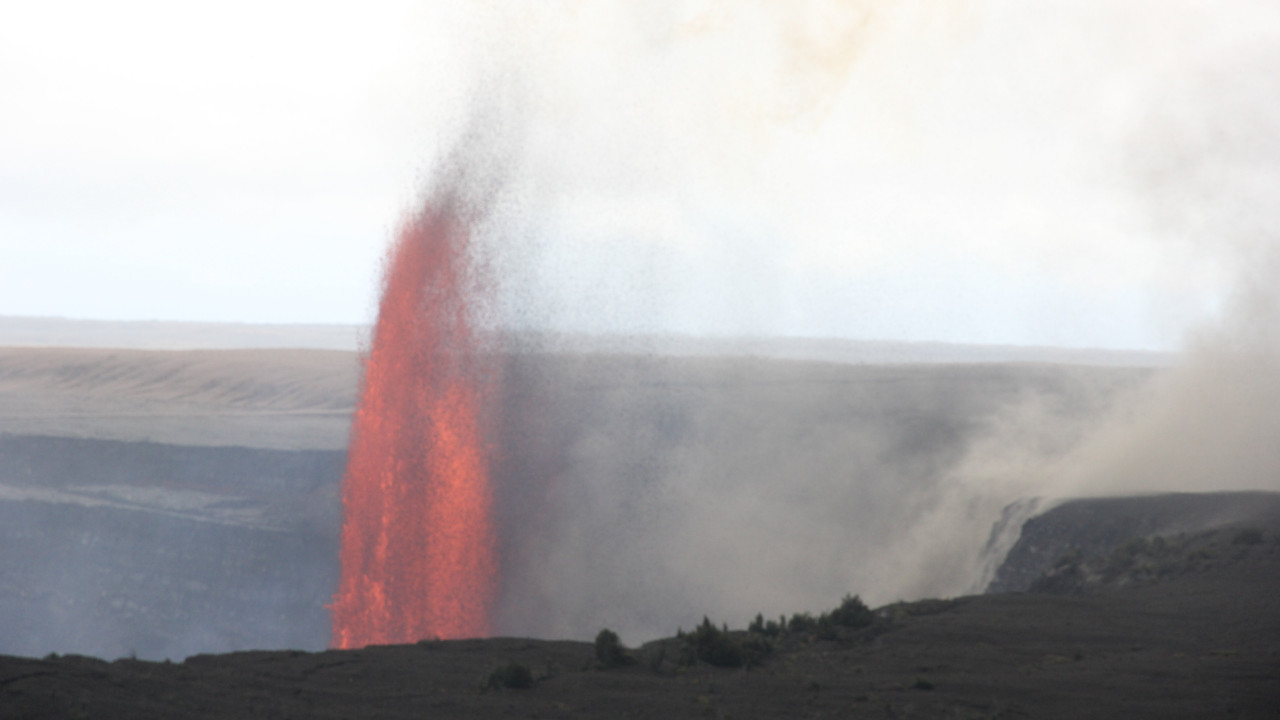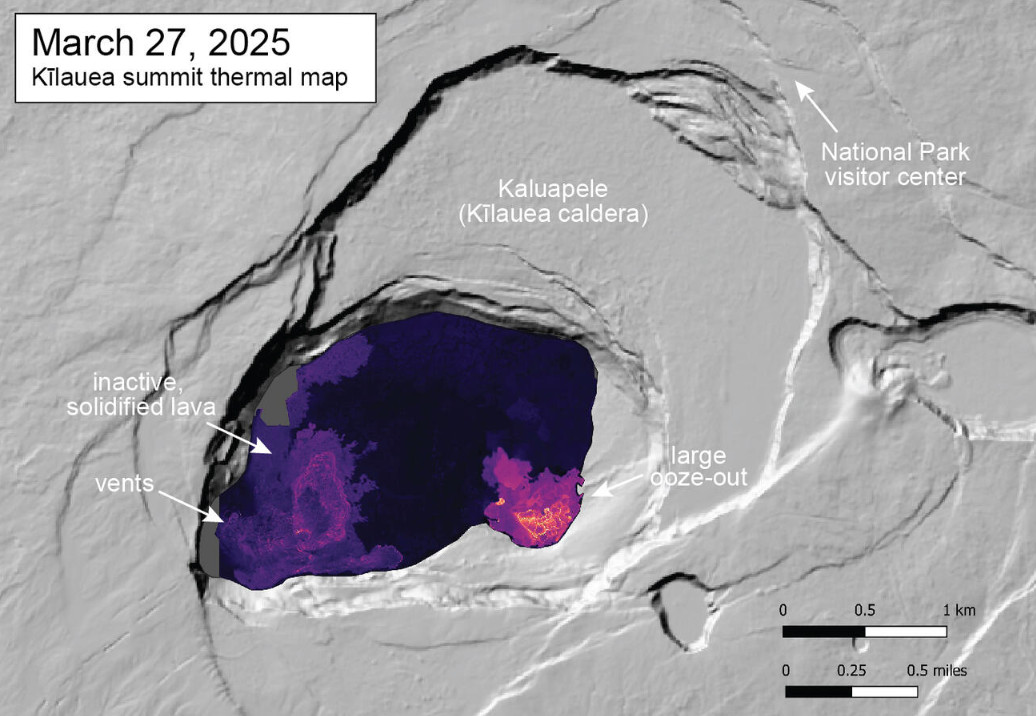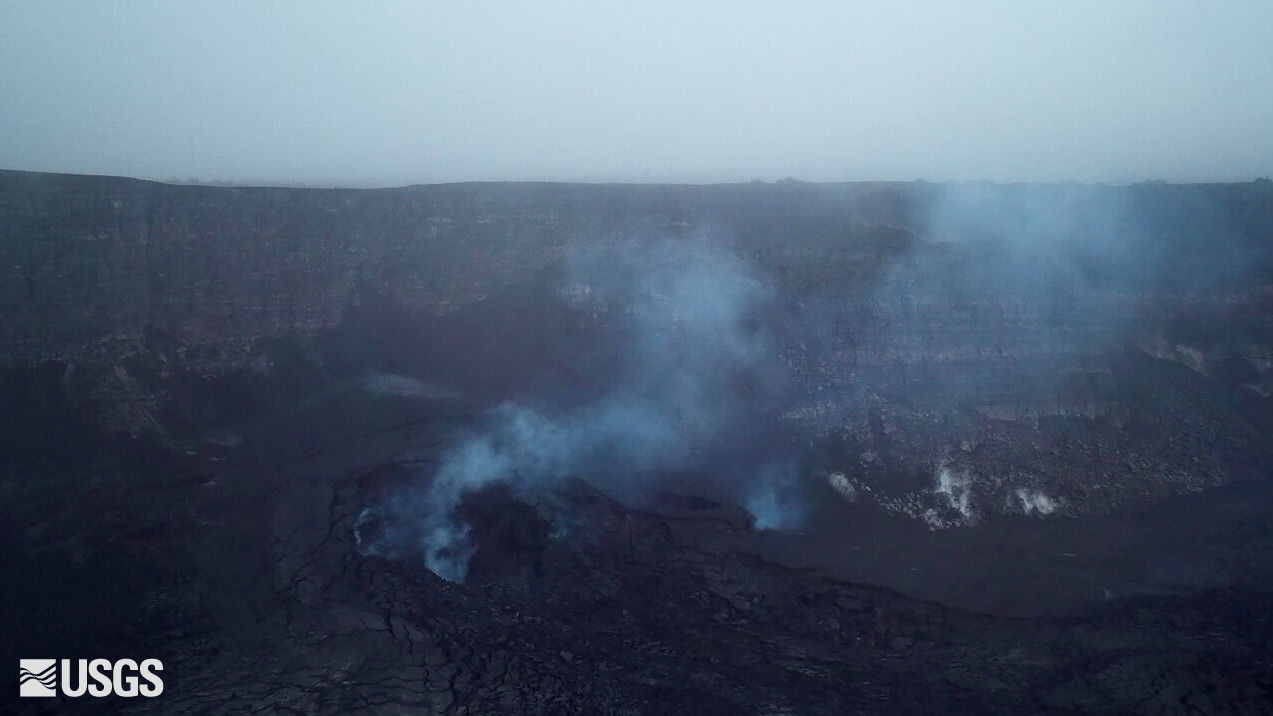(BIVN) – The ongoing eruption at the summit of Kīlauea remains paused following the end of Episode 15, and scientists report the situation “appears substantially different” compared to previous breaks in activity.
Episode 15 featured lava fountains over 1,000 feet (305 meters) high, the tallest of the entire eruption. The episode ended abruptly at 7:10 p.m. on March 26, after erupting for just over 31 hours.
“The current pause has followed the same pattern of reinflation as other pauses,” the USGS Hawaiian Volcano Observatory wrote on Friday. “However, other observations have indicated some differences with this pause.”

USGS: “USGS Hawaiian Volcano Observatory geologists observed the fountain activity and monitored changing fountain heights during episode 15 of the Halema‘uma‘u eruption. This photo was taken at 1:00 p.m. HST on March 26 during the high fountain stage of the episode. Photo direction is looking south. Fountain heights reached up to about 750 feet (230 meters) at this time.” (USGS photo by H. Winslow)
One difference: A few hours following the end of Episode 15, about a dozen small seismic events occurred near the summit.
There was also significant drop in seismic tremor, though it is still present.
The glow from the inactive vents is substantially less than the glow observed after previous episodes.
“A blocking, or sealing, of the vents could partially suppress degassing and thus limit degassing-induced tremor,” HVO scientists wrote.
“The continued inflation of the summit recorded on both the UWD and SDH tiltmeters indicates that magma is being replenished at a rate similar to that seen during prior pauses,” the USGS HVO stated. “Another episode is likely to take place if magma can overcome any blockage of the conduit. Current rates of inflation indicate that a new episode could begin between Monday, March 31, and Wednesday, April 2, if the conduit is re-opened.”
“If additional pressure is required to re-open the conduit, the eruption re-start window could be delayed, or the eruption could end,” the scientists added.

USGS map shows a thermal image of the Kīlauea summit the day after the lava fountaining of Episode 15. Lava ooze-out can be seen emerging from the solidified crater floor in the eastern portion of the crater, “attesting to the fluid nature of lava beneath the crater floor”, scientists wrote.
“The power system that supplies power to the KWcam webcamera, the F1cam thermal camera, and the laser rangefinder sustained damage during the high fountaining on March 26, 2025,” the HVO reported. “Both cameras and the rangefinder are currently offline. Other HVO webcameras are still functioning and online.”
From the USGS HVO update on Friday, March 28th:
Summit Observations:
Episode 15 ended on March 26, 2025. Spots of orange glow can still be seen on the crater floor at night as the erupted lava continues to cool.
The condition of the vents after episode 15 appears substantially different than after the previous eruptive episodes. A small opening in the south vent continues to degas and glow weakly at night. The north vent was inactive for much of the high fountaining of episode 15 and was largely infilled with tephra and spatter from the south vent, so vent glow is essentially absent at the north vent. It may be that the north vent, and to a lesser extent the south vent as well, has become somewhat blocked or sealed by erupted material from episode 15. Overall, vent glow is substantially less than following previous episodes.
Tiltmeters at the summit recorded about 9 microradians of deflation at Uēkahuna (UWD) and 7 microradians of deflations at Sand Hill (SDH) during episode 15. Since the current pause began, SDH and UWD tiltmeters have each recorded approximately 3.5 microradians of inflationary tilt.
Immediately following the end of fountaining on March 26, seismic tremor decreased to near zero. Intermittent tremor returned yesterday (March 27), though at lower levels than during earlier pauses. Tremor has since weakened further, though it is still present.
Volcanic gas emissions likely remain elevated above background, though possibly at lower levels than during other pauses. SO2 emission rates during previous pauses were approximately 1,000 t/d. Wind conditions and widespread vog continue to prevent updated emission rate measurements. Note that today’s voggy conditions are the result of weak winds allowing the very high levels of gas emissions from episode 15 to linger over the area, rather than because of current levels of gas emissions.
Strands of volcanic glass known as Pele’s Hair, as well as small chunks of tephra, have been reported on surfaces throughout the summit area of Hawaiʻi Volcanoes National Park and surrounding communities.


by Big Island Video News4:59 pm
on at
STORY SUMMARY
HAWAIʻI VOLCANOES NATIONAL PARK - The USGS Hawaiian Volcano Observatory reports the pause following Episode 15 is different compared to other pauses.